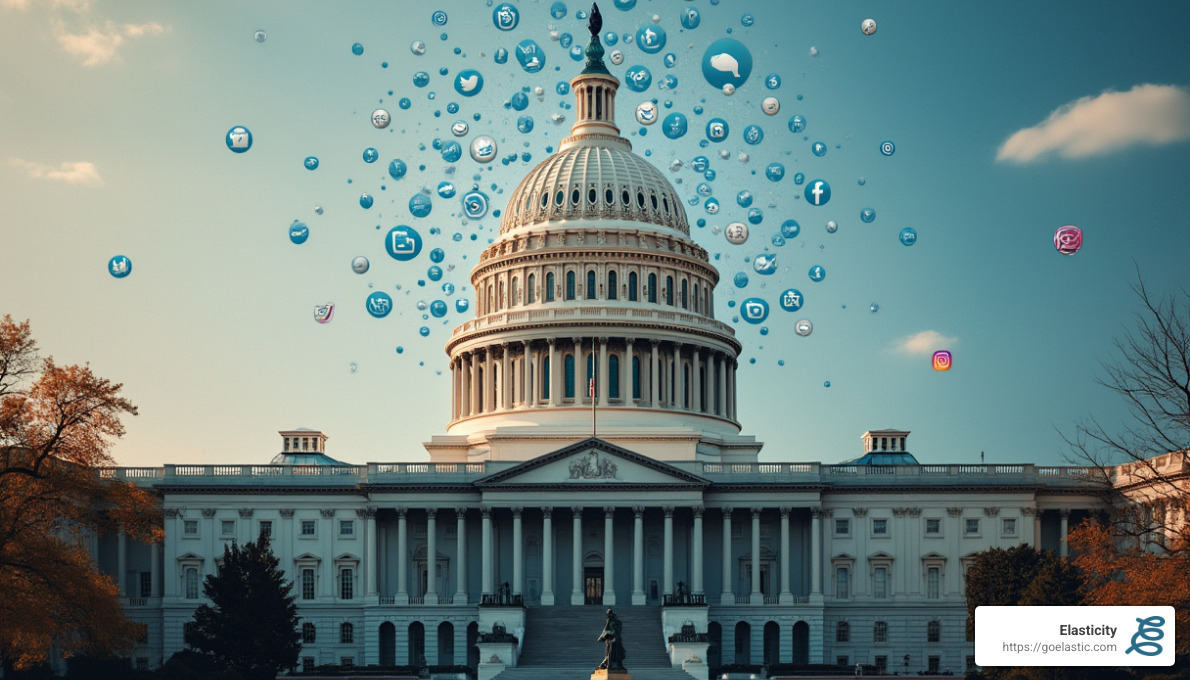Government social media guidelines: 5 Powerful Insights
Government social media guidelines help manage online public engagement, ensure transparency, and address digital media use. Here’s a quick overview to satisfy your curiosity:
- Public Engagement: Guidelines help connect agencies with the public effectively and maintain open communication.
- Transparency: They promote openness in government dealings, reinforcing trust and accountability.
- Digital Media Management: They provide a framework for managing and utilizing evolving digital platforms.
As digital media becomes more ingrained in government operations and public interactions, having structured guidelines is crucial. These rules not only empower government agencies to communicate more effectively but also safeguard the accuracy and trustworthiness of the information shared.
I’m Jen Stamulis. With over ten years of experience in managing campaigns across sectors, I’ve leveraged government social media guidelines to improve digital presence and public engagement. Let’s dive deeper into how these guidelines shape our modern digital landscape and continue into understanding them comprehensively.

Understanding Government Social Media Guidelines
Government social media guidelines are essential for maintaining effective communication, ensuring transparency, and adhering to regulations. Let’s break down what these guidelines involve and why they matter.
Regulations
Government agencies must steer a complex web of regulations when using social media. These rules are designed to ensure that all online activities are lawful and ethical. For example, the HHS Social Media Policies Checklist provides a comprehensive framework to ensure compliance with various legal standards. It covers areas like accessibility, branding, and copyright, ensuring that all content is accessible to everyone, including those with disabilities, and that it respects intellectual property laws.
Moreover, Section 508 mandates that digital content be accessible to individuals with disabilities. This regulation requires that web pages, applications, and attached files meet specific accessibility standards. This ensures that government communication is inclusive and reaches all citizens.
Policies
Policies are the backbone of government social media use. They help define what is acceptable and what isn’t. For instance, comment moderation is a crucial policy area. Comments on government social media pages must be reviewed before posting to prevent the spread of partisan views, commercial endorsements, or offensive content.
Policies also guide the use of official accounts. Government entities must clearly identify themselves using official branding, such as department logos, to avoid confusion about the source of information.
Transparency
Transparency is a core principle of government social media use. It involves providing clear and accurate information to the public. All content posted on third-party sites should be verifiable through an agency’s official website. This ensures that citizens can trust the information they receive and have access to official sources without needing to join a social media platform.
Furthermore, transparency is reinforced through record-keeping practices. All social media interactions must be documented and maintained according to federal records policies. This ensures accountability and allows for auditing if necessary.

In summary, government social media guidelines are crucial for ensuring that digital communications are conducted ethically, legally, and transparently. They not only protect public trust but also improve the effectiveness of government communication in the digital age.
Next, we’ll explore key regulations and policies that further define this landscape.
Key Regulations and Policies
When it comes to government social media guidelines, several key regulations and policies shape how agencies engage with the public online. Let’s explore some of the most significant ones: the SAFE Act, the New York Child Data Protection Act, and DoD regulations.
SAFE Act
The SAFE Act (Social Media and Federal Employees Act) is a crucial piece of legislation that governs how federal employees interact on social media. It emphasizes maintaining a clear boundary between personal opinions and official government positions. This act ensures that employees do not inadvertently represent their agency’s stance while using personal accounts. It also highlights the importance of safeguarding confidential information and adhering to ethical standards.
New York Child Data Protection Act
The New York Child Data Protection Act is designed to protect the privacy of minors on social media platforms. With increasing concerns about the data collection practices of social media companies, this act mandates strict controls. It requires platforms to obtain parental consent before collecting data from users under 18. Additionally, it enforces stringent privacy settings to safeguard young users’ information. This legislation is part of a broader movement to create safer online environments for children, as seen in other states’ regulations.

DoD Regulations
The Department of Defense (DoD) has its own set of comprehensive guidelines for social media use. These regulations are crucial for maintaining national security and operational security (OPSEC). DoD personnel are trained to understand the risks associated with sharing sensitive information online. The guidelines emphasize the importance of not disclosing classified information and maintaining the integrity of military operations. These rules are essential in preventing adversaries from gaining insight into military activities through seemingly harmless social media posts.
In summary, these regulations and policies play a vital role in shaping the landscape of government social media use. They ensure that interactions are conducted safely, ethically, and in compliance with legal standards. Next, we’ll look into best practices for government social media use.
Best Practices for Government Social Media Use
When it comes to government social media, following best practices is essential for maintaining trust, security, and effective communication with the public. Here are some key areas to focus on:
Content Moderation
Content moderation is crucial for maintaining a respectful and informative space. Government agencies should:
-
Set Clear Guidelines: Establish and communicate a comment policy that outlines acceptable behavior. This helps manage expectations and fosters a positive environment.
-
Monitor Activity: Regularly review comments and posts for inappropriate content. If someone violates the guidelines, remind them to be respectful. If necessary, remove offensive comments to maintain a safe space.
-
Handle Threats Seriously: If a comment poses a threat, take a screenshot, report it to the appropriate law enforcement contact, and follow any instructions they provide.
Official Accounts
Using official accounts correctly helps maintain credibility and security:
-
Separate Personal and Official Accounts: Government employees should have distinct personal and official social media accounts. This separation helps avoid confusion about whether they are speaking in a personal or official capacity.
-
Assign Roles Carefully: Limit the number of account admins to reduce security risks. Different roles (e.g., Admin, Editor, Moderator) should be assigned based on specific responsibilities and reviewed regularly.
-
Use Government Devices: Whenever possible, manage official accounts on government-furnished devices to ensure security and compliance with policies.
Privacy
Protecting privacy is a top priority in government social media use:
-
Follow Privacy Regulations: Adhere to laws like the New York Child Data Protection Act, which safeguard user data, especially for minors.
-
Implement Two-Factor Authentication: Improve account security by requiring a second form of verification for logins.
-
Review Third-Party Access: Regularly check and manage third-party apps that have access to social media accounts to prevent unauthorized postings.
These best practices are designed to help government agencies steer the complexities of social media use while maintaining transparency, security, and public trust. Next, we’ll explore the challenges and opportunities in social media governance.
Challenges and Opportunities in Social Media Governance
Navigating social media governance presents both challenges and opportunities for government agencies. Let’s explore some key areas: data protection, ethical considerations, and public interaction.
Data Protection
Data protection is a significant concern in government social media use. Agencies must ensure that personal data is handled with care and in compliance with regulations like the New York Child Data Protection Act.
-
Secure Data Handling: Agencies need robust systems to safeguard personal information. Implementing encryption and secure access protocols can prevent unauthorized data breaches.
-
Transparency in Data Use: Clearly communicate how data is collected, used, and stored. Transparency builds trust and reassures the public that their information is safe.
Ethical Considerations
Ethical considerations are crucial in maintaining integrity and public trust in government social media activities.
-
Avoiding Bias: Ensure that content and interactions are free from political bias. The Hatch Act provides guidance on political activity, emphasizing the importance of neutrality.
-
Inclusive Communication: Content should be accessible to all, including those with disabilities. Following accessibility standards, like providing alt text for images and captions for videos, ensures inclusivity.
Public Interaction
Social media offers unique opportunities for government agencies to engage with the public, but it requires careful management.
-
Responsive Engagement: Use social media to actively listen and respond to public concerns. This can improve public perception and trust in government agencies.
-
Crisis Communication: In emergencies, social media becomes a vital tool for real-time communication. Agencies should have a plan in place to disseminate accurate information quickly.
-
Building Community: By engaging with followers and encouraging dialogue, government agencies can build a sense of community and foster positive relationships with the public.
Balancing these challenges and opportunities is key to effective social media governance in government. Next, we’ll address frequently asked questions about government social media guidelines.
Frequently Asked Questions about Government Social Media Guidelines
What regulations does the government have on social media?
Government social media guidelines are shaped by various regulations to ensure safety, transparency, and ethical use. Two key regulations are the SAFE Act and the New York Child Data Protection Act.
-
SAFE Act: This act focuses on securing online environments, including social media, to protect against cyber threats. It mandates measures like encryption and regular security audits to keep data safe.
-
New York Child Data Protection Act: This law ensures that children’s data is protected. It requires platforms to implement strict privacy controls when handling data from users under 18.
Are government employees allowed to have social media?
Yes, government employees can have social media accounts, but there are rules to follow, especially under the Hatch Act.
-
Hatch Act: This act restricts political activities of federal employees. They can use social media personally but must avoid engaging in partisan political activities, like endorsing candidates or soliciting political contributions, even when off duty.
-
Personal Use Guidelines: Employees should separate personal and professional accounts. They must not use their official role to influence or endorse political content.
What is the social media governance policy?
Social media governance policy outlines how government agencies should manage their online presence, focusing on content creation and brand advocacy.
-
Content Creation: Agencies must ensure content is factual, unbiased, and accessible. Avoiding political bias and ensuring inclusivity are key elements.
-
Brand Advocacy: While employees can promote government initiatives, they must do so in a way that aligns with the agency’s mission and values, maintaining transparency and ethical standards.
These guidelines help government agencies steer the digital landscape effectively. Next, we’ll explore how Elasticity can assist in developing a robust digital strategy that ensures compliance and improves public engagement.
Conclusion
As we steer the digital landscape, it’s clear that government social media guidelines play a crucial role in maintaining transparency, security, and ethical standards. At Elasticity, we understand the complexities of these guidelines and how they shape the digital strategies of government agencies.
Elasticity is committed to helping government agencies develop and implement digital strategies that not only comply with regulations but also improve public engagement. Our approach involves creating content that is factual, accessible, and aligned with the agency’s mission. We focus on ensuring that government communications are transparent and free from political bias, fostering trust and accountability.
Compliance is at the heart of what we do. We stay up-to-date with regulations like the SAFE Act and the New York Child Data Protection Act, ensuring that our strategies protect data and respect privacy. Our expertise in digital strategy helps agencies steer the challenges of social media governance, from content moderation to maintaining official accounts.
By partnering with Elasticity, government agencies can confidently engage with the public while adhering to necessary guidelines. Our marketing and advertising services are designed to support your agency’s digital change, making your online presence both effective and compliant.
In conclusion, as government agencies continue to expand their digital footprint, have a partner like Elasticity to guide them through the complexities of social media governance. Together, we can ensure that your digital strategy not only meets compliance requirements but also strengthens your connection with the public.


